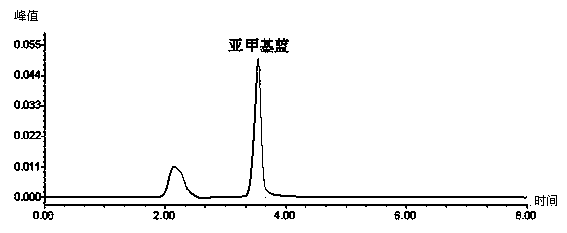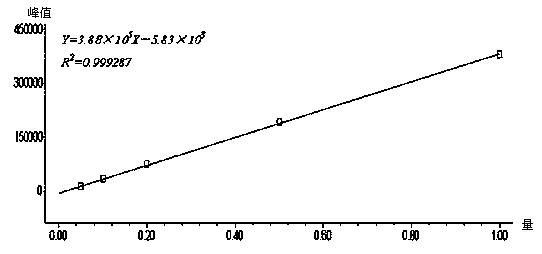High-performance-liquid-chromatography detection method for methylene blue in aquaculture water
A high-performance liquid chromatography and methylene blue technology, which is applied in the field of high-performance liquid chromatography detection of methylene blue in aquaculture water, can solve problems such as being unsuitable for detection of methylene blue in aquaculture water, and achieves low detection cost, accurate qualitative, high sensitivity and precision. Effect
- Summary
- Abstract
- Description
- Claims
- Application Information
AI Technical Summary
Problems solved by technology
Method used
Image
Examples
Embodiment 1
[0026] (1) Water sample pretreatment: After collecting 500 mL of water sample to the laboratory, immediately use a 0.45 μm filter membrane for suction filtration treatment, and transfer the filtrate obtained by suction filtration to a sample bottle.
[0027] (2) Extraction and purification: Select a 250 mL separatory funnel for leak detection and place it on the funnel stand, accurately measure 100 mL of the filtrate and transfer it to a 250 mL separatory funnel, add 40 mL of chromatographically pure dichloromethane for extraction, shake for 1 min and then statically After standing for 20 min, when the liquid in the separatory funnel was stable and obvious stratification appeared, the dichloromethane in the lower layer was transferred to a 100 mL rotary evaporator, and concentrated to dryness in a rotary evaporator at 40 °C under vacuum. After removing the rotary evaporator, accurately add 1.0 mL of methanol to the rotary evaporator to dissolve the residue, and use a rubber-tip...
Embodiment 2
[0035] (1) Water sample pretreatment: After collecting 1000 mL of water sample to the laboratory, immediately use a 0.45 μm filter membrane for suction filtration treatment, and transfer the filtrate obtained by suction filtration to a sample bottle.
[0036] (2) Extraction and purification: Select a 500 mL separatory funnel for leak detection and place it on the funnel stand, accurately measure 250 mL of the filtrate and transfer it to a 500 mL separatory funnel, add 50 mL of chromatographically pure dichloromethane for extraction, shake for 2 minutes and then let it stand After 30 min, when the liquid in the separatory funnel was stable and obvious stratification appeared, the dichloromethane in the lower layer was transferred to a 100 mL rotary evaporator, and concentrated to dryness in a rotary evaporator at 45 °C under vacuum. After removing the rotary evaporator, accurately add 1.0 mL of methanol to the rotary evaporator to dissolve the residue, and use a rubber-tipped st...
Embodiment 3
[0044] (1) Water sample pretreatment: After collecting 1000 mL of water sample to the laboratory, immediately use a 0.45 μm filter membrane for suction filtration treatment, and transfer the filtrate obtained by suction filtration to a sample bottle.
[0045] (2) Extraction and purification: Select a 500 mL separatory funnel for leak detection and place it on the funnel stand, accurately measure 250 mL of the filtrate and transfer it to a 500 mL separatory funnel, add 60 mL of chromatographically pure dichloromethane for extraction, shake for 1 min and then statically After standing for 20 min, when the liquid in the separatory funnel was stable and obvious stratification appeared, the dichloromethane in the lower layer was transferred to a 100 mL rotary evaporator, and concentrated to dryness in a rotary evaporator at 40 °C under vacuum. After removing the rotary evaporator, accurately add 1.0 mL of methanol to the rotary evaporator to dissolve the residue, and use a rubber-ti...
PUM
| Property | Measurement | Unit |
|---|---|---|
| Aperture | aaaaa | aaaaa |
Abstract
Description
Claims
Application Information
 Login to View More
Login to View More - R&D
- Intellectual Property
- Life Sciences
- Materials
- Tech Scout
- Unparalleled Data Quality
- Higher Quality Content
- 60% Fewer Hallucinations
Browse by: Latest US Patents, China's latest patents, Technical Efficacy Thesaurus, Application Domain, Technology Topic, Popular Technical Reports.
© 2025 PatSnap. All rights reserved.Legal|Privacy policy|Modern Slavery Act Transparency Statement|Sitemap|About US| Contact US: help@patsnap.com


